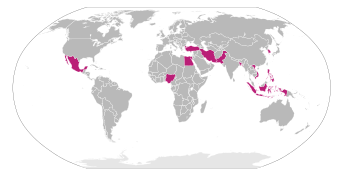Next Eleven
This article may have too many links to other articles, and could require cleanup to meet Wikipedia's quality standards. (April 2018) (Learn how and when to remove this template message) |
Next Eleven | |
|---|---|
 N-11 countries in Magenta | |
| Type | High potential economies |
| Members | 11 Countries
|
The Next Eleven (known also by the numeronym N-11) are the eleven countries – Bangladesh, Egypt, Indonesia, Iran, Mexico, Nigeria, Pakistan, the Philippines, Turkey, South Korea and Vietnam – identified by Goldman Sachs investment banker and economist Jim O'Neill in a research paper as having a high potential of becoming, along with the BRICS countries, among the world's largest economies in the 21st century.[1] The bank chose these states, all with promising outlooks for investment and future growth, on December 12, 2005.
The criteria that Goldman Sachs used were macroeconomic stability, political maturity, openness of trade and investment policies, and the quality of education. The N-11 paper is a follow-up to the bank's 2003 paper on the four emerging "BRIC" economies, Brazil, Russia, India, and China.[2]
Next Eleven countries[edit]
 South Korea :A highly developed country Advanced economy (both CIA and IMF), High-income economy,[3] Very High human development, High-income OECD member, Developed market.[4]
South Korea :A highly developed country Advanced economy (both CIA and IMF), High-income economy,[3] Very High human development, High-income OECD member, Developed market.[4]
 Iran : Upper-middle-income economy,[5] High human development, Theocracy/Parliamentary System.
Iran : Upper-middle-income economy,[5] High human development, Theocracy/Parliamentary System. Indonesia : Lower-middle-income economy,[3] Medium human development, Secondary Emerging market,
Indonesia : Lower-middle-income economy,[3] Medium human development, Secondary Emerging market, Mexico : Upper-middle-income economy,[3] High human development, democracy, OECD member, Advanced Emerging market.
Mexico : Upper-middle-income economy,[3] High human development, democracy, OECD member, Advanced Emerging market. Philippines : Lower-middle-income economy,[3] Medium human development, Secondary Emerging market
Philippines : Lower-middle-income economy,[3] Medium human development, Secondary Emerging market Turkey : Upper-middle-income economy[6] and an advanced emerging market
Turkey : Upper-middle-income economy[6] and an advanced emerging market Bangladesh : Lower-middle-income economy,[7] listed under the developing countries,[7][8] has medium human development[9]
Bangladesh : Lower-middle-income economy,[7] listed under the developing countries,[7][8] has medium human development[9] Egypt : Lower-middle-income economy,[3] Medium human development, Secondary Emerging market
Egypt : Lower-middle-income economy,[3] Medium human development, Secondary Emerging market Nigeria : Lower-middle-income economy,[3] Low human development, Frontier market,[10]
Nigeria : Lower-middle-income economy,[3] Low human development, Frontier market,[10] Pakistan : Lower-middle-income economy,[11] Secondary Emerging market, Hybrid Regime.
Pakistan : Lower-middle-income economy,[11] Secondary Emerging market, Hybrid Regime. Vietnam : Lower-middle-income economy,[3] Medium human development, Frontier market,[10] authoritarian regime,[12] Socialist republic, former satellite state of the Soviet Union.
Vietnam : Lower-middle-income economy,[3] Medium human development, Frontier market,[10] authoritarian regime,[12] Socialist republic, former satellite state of the Soviet Union.
See also[edit]
References[edit]
- ↑ Goldman Sachs's MIST Topping BRICs as Smaller Markets Outperform - Bloomberg
- ↑ Global Economics Paper 134 and Jim O'Neill, BRIMCs
- ↑ 3.0 3.1 3.2 3.3 3.4 3.5 3.6 "Data - Country Groups". World Bank. Retrieved 2009-02-02.
- ↑ Ihlwan, Moon (2009-09-21). "Korea Wins FTSE Developed World Status". BusinessWeek. Retrieved 2012-04-12.
- ↑ Torbat, Akbar E. (2010-09-27). "Industrialization and Dependency: the Case of Iran". Los Angeles: California State University. Retrieved 2011-09-04.
- ↑ "Country and lending groups", World Bank, Retrieved July 2, 2013
- ↑ 7.0 7.1 "Country and Lending Groups". World Bank. Retrieved 2015-03-11.
- ↑ "International Statistical Institute (ISI), 2014". Developing Countries. The International Statistical Institute. Archived from the original on 2015-03-17. Retrieved 2015-03-11.
- ↑ "Bangladesh Economy is a Star in the World Economy says UN Expert" (PDF). United Nations. 2011. Retrieved July 6, 2013.
- ↑ 10.0 10.1 See FTSE frontier markets list
- ↑ "Country and Lending Groups | Data". Data.worldbank.org. Retrieved 2012-04-12.
- ↑ "Vietnam country profile - Overview". BBC News. 2012-01-15. Retrieved 2012-04-12.
Further reading[edit]
- "The N-11: More Than an Acronym" – Goldman Sachs study of N-11 nations, Global Economics Paper No: 153, March 28, 2007.
Template:Next 11 Economies Template:Leaders of the Next Eleven Economies
This article "Next Eleven" is from Wikipedia. The list of its authors can be seen in its historical and/or the page Edithistory:Next Eleven. Articles copied from Draft Namespace on Wikipedia could be seen on the Draft Namespace of Wikipedia and not main one.
